The European Union’s overall strategy for the movement of labour

- Author: Gönül Oǧuz
- Main Title: EU Enlargement and Turkish Labour Migration , pp 93-115
- Publication Date: April 2013
- DOI: https://doi.org/10.18356/a4f5a2a7-en
- Language: English
Since the inception of European integration in the 1950s, the principle of labour movement has been a cornerstone of the policies of the European Community (EC) and the European Union (EU). From these early initiatives, the opening of labour markets was a comparatively radical change. Over time, the Treaty of Rome’s delimitation of the free movement of labour has been deepened, expanded and transformed by subsequent treaties. There have been problems within the EU’s migration strategy so far. The main objective of this chapter is to present the problem of European labour migration and analyse the implications of policy outcomes for Turkish labour flows. I first provide the necessary background information at the European level to frame the national immigration policies. This lays the foundation for a discussion that examines the development of EU policies. I then elaborate the obstacles to EU policies by pointing out the challenges to and pressures on Turkish labour flows.
© United Nations
ISBN (PDF):
9789210552868
Book DOI:
https://doi.org/10.18356/0e44c90c-en
Related Subject(s):
Migration
Sustainable Development Goals:
-
From This Site
/content/books/9789210552868c006dcterms_title,dcterms_subject,pub_keyword-contentType:Journal -contentType:Contributor -contentType:Concept -contentType:Institution105
/content/books/9789210552868c006
dcterms_title,dcterms_subject,pub_keyword
-contentType:Journal -contentType:Contributor -contentType:Concept -contentType:Institution
10
5

